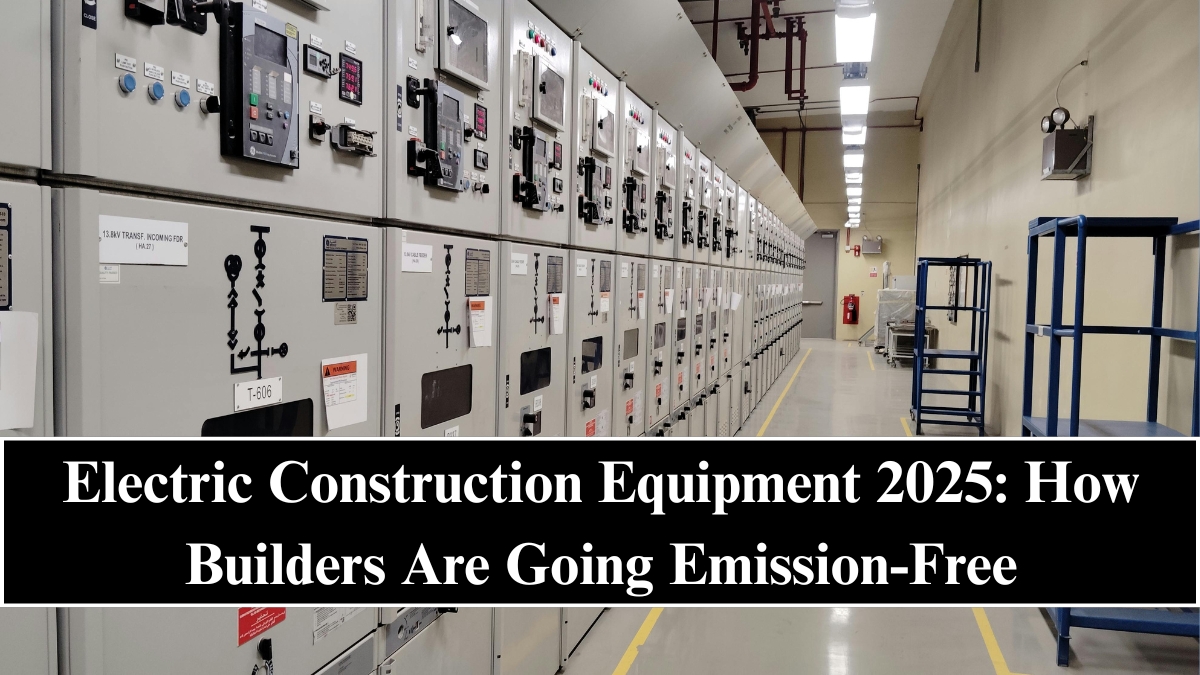The construction industry, once considered one of the largest carbon emitters, is undergoing a major transformation in 2025. The rise of electric construction equipment—from excavators and loaders to cranes and dump trucks—is driving a global shift toward zero-emission building sites. With governments tightening emission norms and companies embracing green technology, electric machinery is now redefining both sustainability and performance across the construction sector.

Why Construction Is Going Electric
Heavy machinery has long relied on diesel engines, contributing to significant air and noise pollution. However, as global climate goals push for net-zero targets, the construction industry is being forced to evolve.
By 2025, manufacturers like Volvo Construction Equipment, Caterpillar, JCB, and Komatsu have launched fully electric or hybrid versions of their most popular machines. These machines not only reduce emissions but also offer improved energy efficiency, lower operating costs, and quieter performance — crucial in urban projects.
Governments are incentivizing the shift through subsidies, low-emission contracts, and green infrastructure policies, making electric equipment a practical and profitable choice.
Key Electric Machines Transforming Job Sites
-
Electric Excavators: Compact excavators powered by lithium-ion batteries now run for 6–8 hours per charge, ideal for small and medium-scale projects.
-
Electric Wheel Loaders: With instant torque and zero idle time, electric loaders improve efficiency while reducing maintenance costs.
-
Electric Dump Trucks: Large-capacity electric dumpers from companies like Komatsu and Hitachi now handle long shifts with regenerative braking systems.
-
Battery-Powered Cranes: Capable of lifting heavy loads with precision and minimal noise, perfect for sensitive urban environments.
Together, these advancements are paving the way for fully electrified construction fleets by the end of the decade.
The Benefits of Electrification in Construction
The advantages of switching to electric construction machinery go far beyond environmental impact:
-
Zero Tailpipe Emissions: Helps companies comply with green building regulations.
-
Reduced Noise Pollution: Essential for urban and residential construction zones.
-
Lower Operating Costs: Electricity is cheaper than diesel, and electric motors require less maintenance.
-
Improved Worker Health: No harmful exhaust fumes or vibrations, creating safer job sites.
-
Enhanced Performance: Instant torque delivery enables faster cycle times and better precision.
Many construction firms report up to 30% savings in operating costs and 40% reduction in maintenance frequency after adopting electric fleets.
Global Push Toward Green Construction
Countries worldwide are now setting targets for low- or zero-emission construction zones:
-
Norway and Sweden have already mandated fully electric construction projects in select cities.
-
Germany and the UK provide tax breaks for electric machinery procurement.
-
India and China are promoting localized manufacturing of e-machinery under clean energy initiatives.
In 2025, major urban projects — from smart city developments to metro expansions — are incorporating electric fleets to meet environmental standards and ESG commitments.
Challenges: Power, Cost, and Infrastructure
Despite its promise, electric construction technology faces several challenges:
-
High upfront costs due to advanced battery systems.
-
Limited charging infrastructure on remote or off-grid sites.
-
Energy supply fluctuations, especially in developing regions.
To address these, innovators are introducing mobile charging trucks, solar-powered site chargers, and battery-swapping systems. These ensure consistent power delivery even in rugged construction environments.
AI and Automation in Electric Construction
Artificial intelligence and automation are enhancing electric equipment efficiency. In 2025, many electric machines feature:
-
Predictive maintenance sensors that alert operators before breakdowns.
-
Autonomous navigation systems for repetitive tasks like digging or material transport.
-
Energy optimization software that adjusts performance for terrain and workload.
Companies like Volvo CE and Caterpillar are investing heavily in AI-driven, zero-emission job sites where entire fleets work collaboratively and efficiently.
The Road Ahead: Fully Emission-Free Job Sites
By 2030, the construction industry aims for 100% electrified job sites powered by renewable energy sources like solar and wind. In 2025, that vision is already taking shape, with hybrid sites combining electric equipment and portable renewable power generators.
The shift toward electric construction equipment isn’t just a technological upgrade — it’s a cultural transformation. Builders are no longer choosing between performance and sustainability; they’re achieving both.
As global infrastructure demands grow, the future of construction is clear — quiet, clean, and fully electric.
FAQs
What types of electric construction equipment are available in 2025?
Electric excavators, loaders, dump trucks, and cranes are now widely available, with models for both small and large-scale construction.
How long can electric construction machines operate on a single charge?
Most compact electric machines last 6–10 hours, while larger units use swappable batteries or hybrid systems for extended operations.
Are electric construction machines powerful enough for heavy-duty work?
Yes. With instant torque and advanced control systems, they often outperform diesel machines in efficiency and precision.
What are the main benefits of switching to electric machinery?
Electric equipment reduces emissions, noise, and maintenance costs, while improving productivity and worker safety.
What challenges remain for electric construction equipment adoption?
High purchase cost and limited on-site charging remain key barriers, though mobile chargers and solar integration are rapidly solving these issues.
Click here to know more.
